The Tinted Cosmetics Market is estimated to be valued at USD 1.7 billion in 2025 and is projected to reach USD 2.6 billion by 2035, registering a compound annual growth rate (CAGR) of 4.3% over the forecast period.
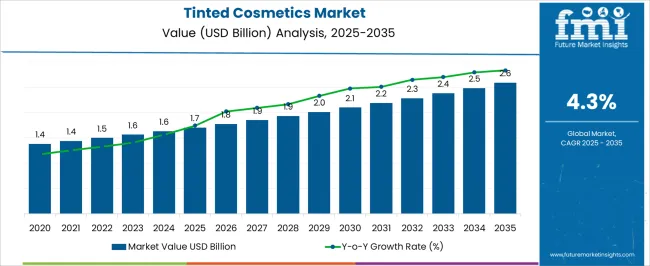
| Metric | Value |
|---|---|
| Tinted Cosmetics Market Estimated Value in (2025 E) | USD 1.7 billion |
| Tinted Cosmetics Market Forecast Value in (2035 F) | USD 2.6 billion |
| Forecast CAGR (2025 to 2035) | 4.3% |
The tinted cosmetics market is experiencing robust growth driven by shifting consumer preferences toward multifunctional beauty products that combine aesthetic appeal with skincare benefits. Increasing demand for products that offer sun protection, hydration, and light coverage has positioned tinted cosmetics as daily essentials in both urban and emerging markets.
The rise of wellness focused beauty and minimalistic routines has further reinforced the demand for hybrid formulations that cater to skin tone enhancement and environmental protection. Industry players are responding with product innovation, clean label ingredients, and dermatologically tested formulations that meet evolving expectations for performance and safety.
Social media influence, coupled with rising male grooming awareness and inclusive shade ranges, is expanding the consumer base. With growing acceptance of natural looks and convenient all in one solutions, the market outlook remains positive across both developed and developing regions.
The market is segmented by Product Type, Application, Consumer Orientation, Nature of Product, and Distribution Channel and region. By Product Type, the market is divided into Sunscreens, Moisturizers, Foundation, Cheek or Lip Tints, Balms, and Others. In terms of Application, the market is classified into Face cosmetics, Cheek and Lips cosmetics, Eye cosmetics, and Hair cosmetics. Based on Consumer Orientation, the market is segmented into Men, Women, and Unisex. By Nature of Product, the market is divided into Conventional and Natural. By Distribution Channel, the market is segmented into Hypermarket/Supermarket, Specialty Stores, Pharmacies, Independent Stores, and Online Store. Regionally, the market is classified into North America, Latin America, Western Europe, Eastern Europe, Balkan & Baltic Countries, Russia & Belarus, Central Asia, East Asia, South Asia & Pacific, and the Middle East & Africa.
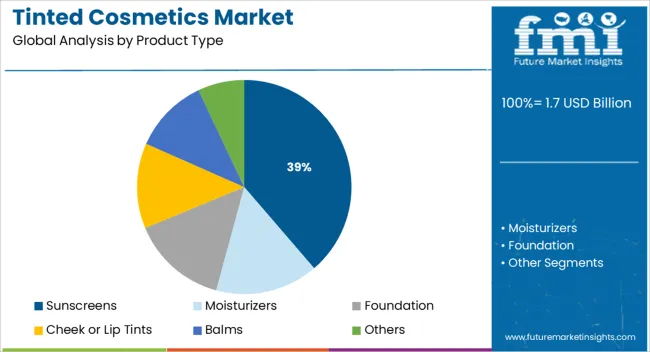
The sunscreens segment is anticipated to hold 38.70% of total market revenue by 2025 within the product type category, making it the leading segment. This growth is supported by increasing consumer awareness of UV protection, rising concerns about photoaging, and a preference for lightweight sun care alternatives that also offer skin tone correction.
Tinted sunscreens are being favored for their dual function, combining broad spectrum sun protection with complexion smoothing properties that eliminate the need for heavy foundation. Their suitability for sensitive skin types and compatibility with daily skincare regimens have also contributed to widespread adoption.
The convenience of an all in one product that delivers both cosmetic and dermatological benefits continues to drive demand, positioning this segment at the forefront of the product landscape.
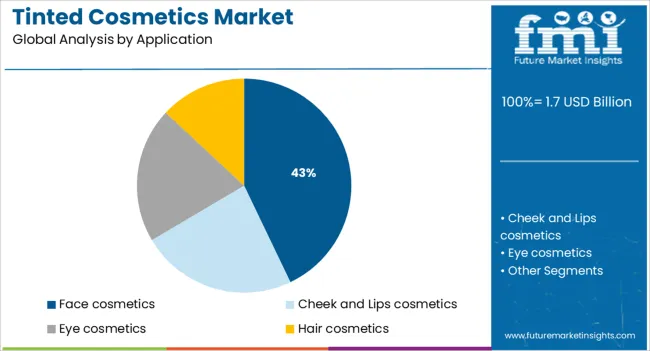
The face cosmetics segment is projected to account for 42.90% of market revenue by 2025 under the application category, representing the dominant share. This is driven by growing demand for lightweight, breathable, and skin enhancing cosmetic solutions.
Consumers are increasingly choosing tinted moisturizers, BB creams, and tone correcting creams over traditional foundations due to their natural finish and skincare integration. The expansion of clean beauty trends and the availability of dermatologically approved formulations have further strengthened consumer trust.
Additionally, face cosmetics offer high versatility for various skin types and tones, meeting diverse beauty expectations. As cosmetic users seek daily wear solutions that blend coverage with skincare, this application continues to maintain its leading position within the tinted cosmetics market.
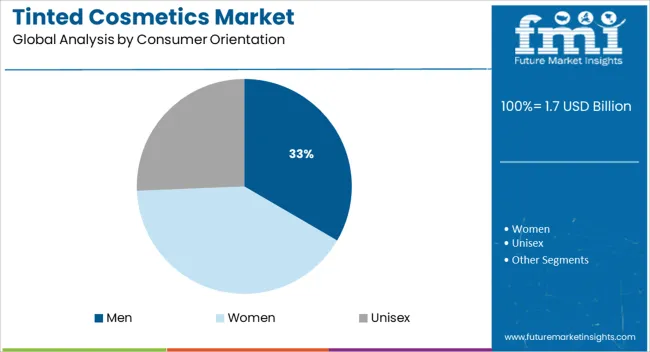
The men segment is expected to contribute 33.40% of total revenue by 2025 under the consumer orientation category, establishing it as a key growth segment. This rise is fueled by evolving perceptions of male grooming, increased product accessibility, and targeted marketing that normalizes cosmetic use among men.
Tinted cosmetics formulated for men are gaining traction due to their discreet finish, non greasy texture, and skin friendly benefits that address concerns such as uneven skin tone, sun exposure, and blemishes. The segment’s growth is further accelerated by the influence of social media, lifestyle influencers, and rising awareness around skincare routines for men.
With increasing comfort in personal appearance enhancement and broader brand inclusivity, men are emerging as a substantial consumer base in the tinted cosmetics category.
As per FMI, global sales of tinted cosmetics grew at a sluggish pace during the historical period from 2020 to 2024. However, with the growing trend of Skinimalism and increasing consumer awareness about the benefits of using these tinted cosmetics, the overall market is set to accelerate at a steady pace of 4.3% CAGR between 2025 and 2035.
Tinted cosmetics are a subset of cosmetic products that incorporate pigments. These pigments can be used to enhance the skin's complexion or to conceal dark patches and uneven skin tone. Some tinted cosmetics are designed to provide extra advantages, such as making the skin shine and keeping it moisturized.
Consumers choose tinted cosmetic products because they mimic the natural skin tone and provide a make-up-free, natural glow to the complexion. These cosmetics are not just utilized by women but men are also increasingly requesting tinted moisturizers and serums as skincare products become more popular.
Manufacturers are also focused on tinted cosmetic product improvements. Many major manufacturers have produced products that possess multipurpose properties. People are selecting items derived from natural materials as they become more conscious of the usage of chemical substances in cosmetic and make-up products. Manufacturers are beginning to offer cosmetic products manufactured with natural chemicals in response to rising demand.
Rising Trend of Skinimalism and Availability of Multifunctional Cosmetics Boosting Sales
Tinted cosmetics are used to impart a glow to natural skin and to achieve a makeup-free look. Skinimalism and minimal cosmetics are becoming new trends in the fashion industry globally.
Women are making every effort to appear as natural as possible. Tinted cosmetics are commonly used to accomplish this look because they are suitable for all skin tones and improve the appearance without the use of heavy makeup. Increased skin color awareness is also increasing demand for and sales of tinted cosmetics.
There are cosmetic products with only certain benefits. However, multifunctional goods are becoming increasingly popular because they can handle numerous tasks at once. Many tinted cosmetics are multipurpose items that provide a glow to the complexion while also moisturizing and protecting the skin from impurities such as dirt and particle matter and also acting as a sunblock and antibacterial ingredient that aid in acne prevention.
Penetration of Fake Products and Regulations on Chemical Compounds Badly Impacting Market
The tinted cosmetics business is hampered by a variety of factors, the most significant of which are counterfeit products, prohibitions on the use of chemical compounds, and fierce competition among the leading manufacturers.
Local manufacturers counterfeit top brands, and these products are of poor quality. There may be some hazards to the skin by using these products. Such items can harm the reputation of well-known businesses and reduce sales of genuine products.
Several reputable brands manufacture tinted cosmetics with various functions and benefits. These brands are constantly competing to gain an advantage and dominate the market. The high number of manufacturing companies, new entrants into the industry, and their competitiveness are also influencing the market to some extent.
Cosmetics contain several chemical ingredients that may be prohibited or limited for usage by the regional authorities. Tinted cosmetic goods face limited sales as a result of such limitations, affecting market expansion.
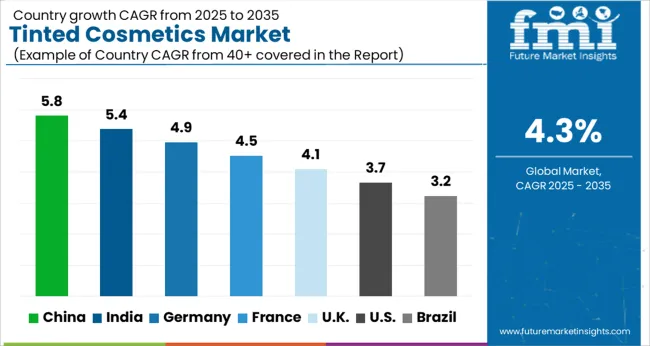
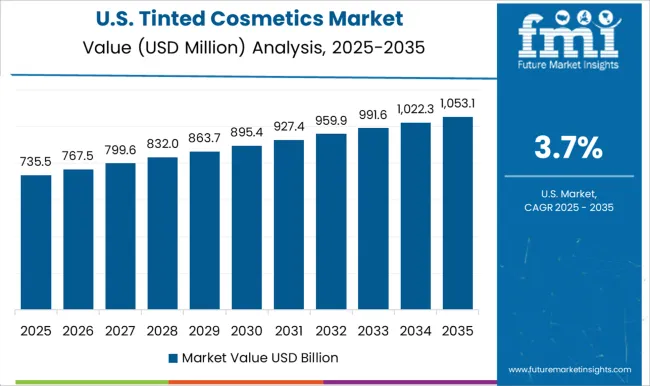
Growing Trend of Skinimalism Boosting Sales in the USA
According to Future Market Insights, the USA tinted cosmetics industry is projected to expand at a steady pace during the forecast period owing to the rising trend of skinimalism, increasing spending on cosmetics by American women, and the heavy presence of leading tinted cosmetic manufacturers.
Skinimalism is a growing trend around the world, and it has a significant impact on the female population in the USA. It simply means using minimum cosmetics for skin maintenance and maintaining a natural appearance at all times.
Throughout the world, American women used the most skin care products and cosmetics, and on average American people spend USD 250 to USD 320 on cosmetic products every month. Many people developed skin problems because of the overuse of heavy makeup and cosmetic goods.
In order to address this issue as well as to enhance their looks, American women shifted their focus towards tinted cosmetics. This is expected to generate high demand for tinted cosmetics like foundation and moisturizers in the USA during the forecast period.

Focus on Getting a Light and No Makeup Look Pushing Demand for Tinted Cosmetics in Korea
Demand for tinted cosmetics across South Korea is expected to grow at a moderate CAGR during the next ten years owing to the rising consumer preference to get a light and no makeup look.
South Korea is one of the biggest manufacturers and consumers of cosmetic products. Import of cosmetic products from South Korea in 2024 was about USD 560 million and this number is likely to further rise during the upcoming years due to the influence of social media. The prominence of K-Pop and K-Drama in the Korean entertainment industry has spurred female and male experimentation with diverse looks and haircuts.
Both Korean men and women often use skin tints and tinted blushes to enhance the skin complexion and achieve a no-makeup look. All these factors are increasing the sales of tinted cosmetics in Korea.
Face Cosmetics to Create Maximum Profit for Tinted Cosmetics Manufacturers
Based on application, the face cosmetics category holds over 42% share of the global tinted cosmetics industry and it is expected to grow at a higher CAGR over the next ten years. This can be attributed to the rising consumption of tinted face cosmetics such as sunscreens, moisturizers, foundation, and lip tints.
Face-tinted cosmetics are the most commonly used products by people throughout the world These products include moisturizers, serums, and foundations. Men and women use these products for protecting their faces as well as to get a natural glow.

Key players in the tinted cosmetics industry are Live Tinted, Nykaa, Ulta, Tint Cosmetics, e.l.f., Lab Series, Maybelline, Lakmé, Rare Beauty, Oriflame, Nivea, Bobbi Brown, BareMinerals, Kosas, and others. These players are continuously upgrading their product portfolios through new product launches. Furthermore, they are partnering and collaborating with other brands or celebrities to expand their customer base. For instance,
| Attribute | Details |
|---|---|
| Estimated Market Size (2025) | USD 1.7 billion |
| Projected Market Size (2035) | USD 2.6 billion |
| Anticipated Growth Rate (2025 to 2035) | 4.3% CAGR |
| Historical Data Available for | 2020 to 2024 |
| Forecast Period | 2025 to 2035 |
| Quantitative units | Revenue in USD Million, volume in Units, and CAGR from 2025 to 2035 |
| Segments Covered | Application, Product Type, Consumer Orientation, Nature of Product, Distribution Channel, and Region |
| Key Regions Covered | North America; Latin America; Europe; East Asia; South Asia; Middle East and Africa; and Oceania |
| Key Countries Covered | USA, Canada, Mexico, Germany, United Kingdom, France, Italy, Spain, Russia, India, Thailand, China, India, Japan, Australia, Brazil, Argentina, Colombia, Saudi Arabia, United Arab Emirates(UAE), South Africa |
| Key Companies Profiled | Live Tinted; Nykaa; Ulta; Tint Cosmetics; e.l.f.; Lab Series; Maybelline; Lakmé; Oriflame; Nivea; Bobbi Brown; BareMinerals; Kosas; Rare Beauty; Others |
| Report Coverage | Revenue forecast, volume forecast, company ranking, competitive landscape, growth factors, and trends, pricing analysis |
The global tinted cosmetics market is estimated to be valued at USD 1.7 billion in 2025.
The market size for the tinted cosmetics market is projected to reach USD 2.6 billion by 2035.
The tinted cosmetics market is expected to grow at a 4.3% CAGR between 2025 and 2035.
The key product types in tinted cosmetics market are sunscreens, moisturizers, foundation, cheek or lip tints, balms and others.
In terms of application, face cosmetics segment to command 42.9% share in the tinted cosmetics market in 2025.






Our Research Products

The "Full Research Suite" delivers actionable market intel, deep dives on markets or technologies, so clients act faster, cut risk, and unlock growth.

The Leaderboard benchmarks and ranks top vendors, classifying them as Established Leaders, Leading Challengers, or Disruptors & Challengers.

Locates where complements amplify value and substitutes erode it, forecasting net impact by horizon

We deliver granular, decision-grade intel: market sizing, 5-year forecasts, pricing, adoption, usage, revenue, and operational KPIs—plus competitor tracking, regulation, and value chains—across 60 countries broadly.

Spot the shifts before they hit your P&L. We track inflection points, adoption curves, pricing moves, and ecosystem plays to show where demand is heading, why it is changing, and what to do next across high-growth markets and disruptive tech

Real-time reads of user behavior. We track shifting priorities, perceptions of today’s and next-gen services, and provider experience, then pace how fast tech moves from trial to adoption, blending buyer, consumer, and channel inputs with social signals (#WhySwitch, #UX).

Partner with our analyst team to build a custom report designed around your business priorities. From analysing market trends to assessing competitors or crafting bespoke datasets, we tailor insights to your needs.
Supplier Intelligence
Discovery & Profiling
Capacity & Footprint
Performance & Risk
Compliance & Governance
Commercial Readiness
Who Supplies Whom
Scorecards & Shortlists
Playbooks & Docs
Category Intelligence
Definition & Scope
Demand & Use Cases
Cost Drivers
Market Structure
Supply Chain Map
Trade & Policy
Operating Norms
Deliverables
Buyer Intelligence
Account Basics
Spend & Scope
Procurement Model
Vendor Requirements
Terms & Policies
Entry Strategy
Pain Points & Triggers
Outputs
Pricing Analysis
Benchmarks
Trends
Should-Cost
Indexation
Landed Cost
Commercial Terms
Deliverables
Brand Analysis
Positioning & Value Prop
Share & Presence
Customer Evidence
Go-to-Market
Digital & Reputation
Compliance & Trust
KPIs & Gaps
Outputs
Full Research Suite comprises of:
Market outlook & trends analysis
Interviews & case studies
Strategic recommendations
Vendor profiles & capabilities analysis
5-year forecasts
8 regions and 60+ country-level data splits
Market segment data splits
12 months of continuous data updates
DELIVERED AS:
PDF EXCEL ONLINE
Tinted Moisturizer Cream Market Size and Share Forecast Outlook 2025 to 2035
Tinted Sunscreen Market Size and Share Forecast Outlook 2025 to 2035
Tinted Glass Market Growth - Trends & Forecast 2025 to 2035
Peptide-Infused Tinted Moisturizers Market Size and Share Forecast Outlook 2025 to 2035
Cosmetics ODM Market Analysis – Size, Trends & Forecast 2025-2035
Pet Cosmetics Market Size and Share Forecast Outlook 2025 to 2035
Nutricosmetics Market Analysis - Growth, Trends & Forecast 2025 to 2035
Market Share Breakdown of Nutricosmetics Manufacturers
Halal Cosmetics Market Size and Share Forecast Outlook 2025 to 2035
Japan Cosmetics ODM Market Analysis - Size, Share & Trends 2025 to 2035
Vegan Cosmetics Market Analysis - Trends, Growth & Forecast 2025 to 2035
Colour Cosmetics Market Size and Share Forecast Outlook 2025 to 2035
Organic Cosmetics Market Size and Share Forecast Outlook 2025 to 2035
Premium Cosmetics Market Size and Share Forecast Outlook 2025 to 2035
Natural Cosmetics Market - Size, Share, and Forecast 2025-2035
UK Nutricosmetics Market Growth – Demand, Trends & Forecast 2025-2035
USA Nutricosmetics Market Trends – Size, Share & Growth 2025-2035
GCC Nutricosmetics Market Outlook - Size, Growth & Trends 2025-2035
Waterless Cosmetics Powders Market Size and Share Forecast Outlook 2025 to 2035
Anti-acne Cosmetics Market Size and Share Forecast Outlook 2025 to 2035

Thank you!
You will receive an email from our Business Development Manager. Please be sure to check your SPAM/JUNK folder too.
Chat With
MaRIA